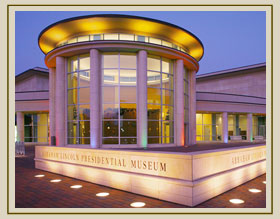 |
Champaign Christian DeWitt Edgar Livingston Logan Macon Mason McLean Menard Moultrie Piatt Sangamon Shelby Tazewell Vermilion Woodford Sangamon County Sangamon County was formed in 1821 out of Madison and Bond Counties and was named for the Sangamon River, which runs through it. The name of the river comes from a Pottawatomie word Sain-guee-mon meaning "where there is plenty to eat." Surprisingly, Springfield’s original name was Calhoun, after Senator John C. Calhoun of South Carolina. The land that Springfield now occupies was originally settled by trappers and traders who came to the Sangamon River in 1818. John Kelly built the settlement's first cabin in 1820 and its site is at the northwest corner of Second Street and Jefferson Street. In 1821, Calhoun became the county seat of Sangamon County; due to the fertile soil, and trading opportunities, settlers from Kentucky, Virginia, and as far as North Carolina came to the city. By 1832, Senator Calhoun had fallen out of the favor with the public and the town was renamed Springfield. By 1837, Springfield became the capital for the state of Illinois, moving it from Vandalia. The designation was largely due to the efforts of Abraham Lincoln and his fellow delegates; nicknamed the "Long Nine." The Civil War brought mixed blessings to Springfield. The war took men to fight, but returned many economic benefits in the form of new industries and businesses. The growing railroads made Springfield an important link in the state railway system. By 1900, coal mining was a major occupation along with politics and farming. The home of the only home Mr. Lincoln ever owned, as well as his three official law partnerships and last law office, Springfield is a treasure trove of Mr. Lincoln’s life and legacy. Among the over 30 Springfields in the United States, this city is certainly unique. Only Springfield, Illinois was the home of one of the most beloved historic figures in the world. As Mr. Lincoln’s Hometown, they host visitors from all over the United States and the world who come to experience the Lincoln tradition! By looking at the pictures below, you can get an idea of Springfield and Sangamon County in Lincoln’s time and as it stands today. Maybe you’ll find something unexpected when you go Looking for Lincoln in Springfield! Then


 Now 





Following the route of Lincoln on the Eighth Judicial Circuit is easy, to learn more about the history of the courthouse in this county, just click here! You may also want to consider a stop by the following sites of interest! Lincoln Home National Historic Site Lincoln-Herndon Law Office Old State Capitol State Historic Site Lincoln Tomb Oak Ridge Cemetery Abraham Lincoln Presidential Library and Museum Illinois State Museum Lincoln Library Springfield Union Station Lincoln Depot Vachel Lindsay Home State Historic Site Lincoln Memorial Garden Elijah Iles House For more information on Sangamon County or the city of Springfield, please visit: http://www.visit-springfieldillinois.com |


























